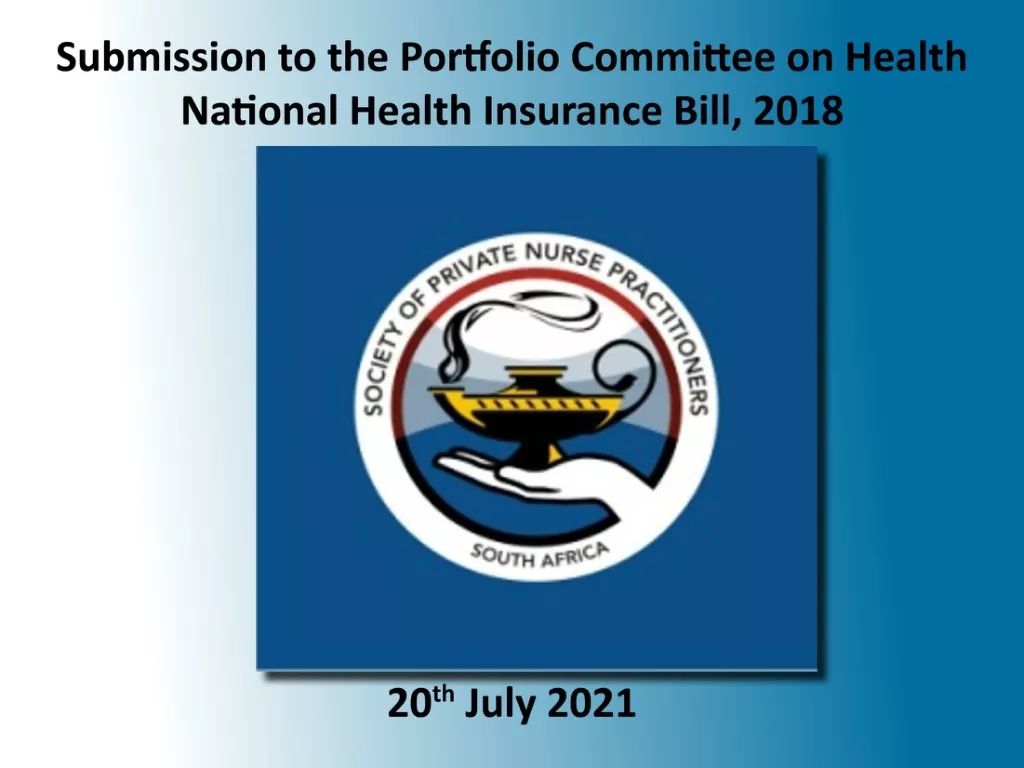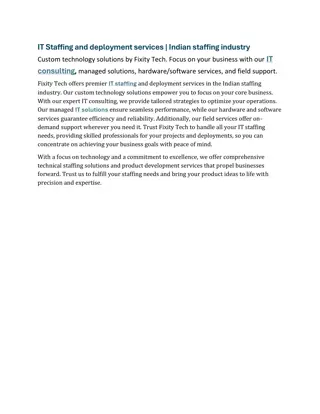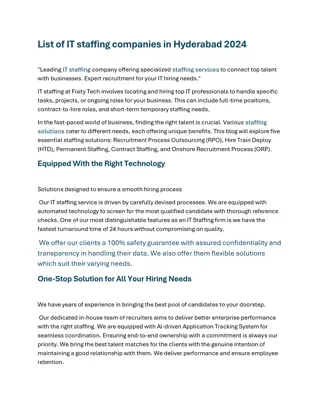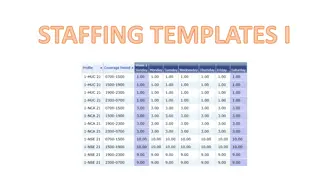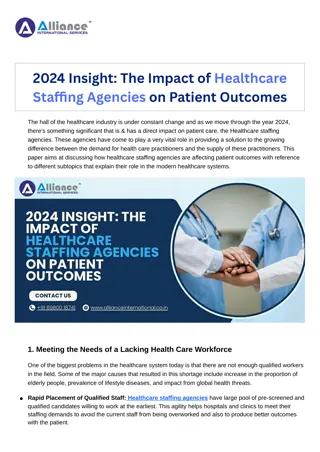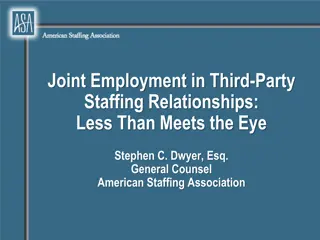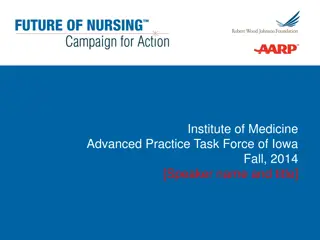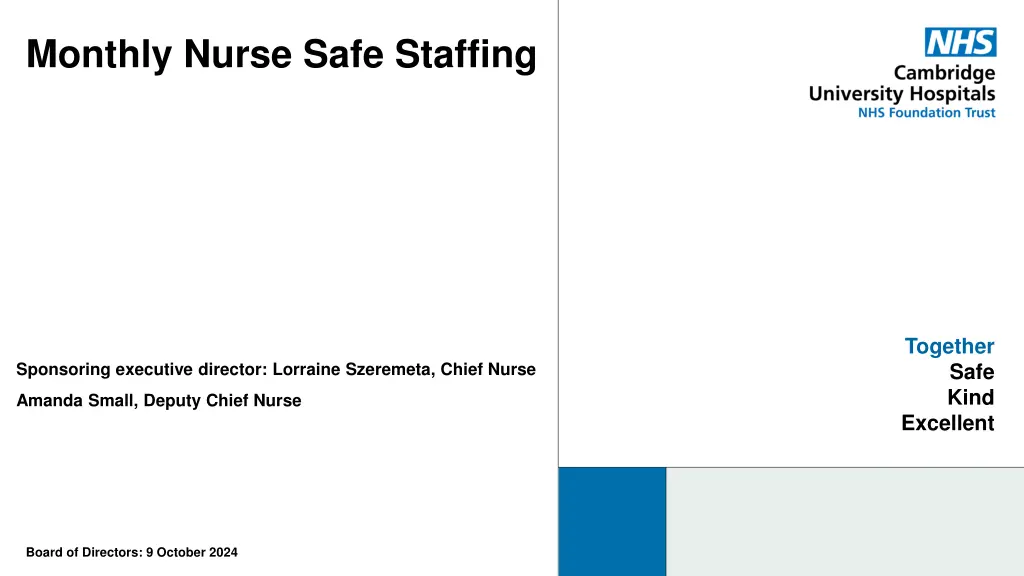
Nursing and Midwifery Staffing Report August 2024
This report provides an overview of the nursing and midwifery staffing position for August 2024, including vacancy rates, turnover rates, rota fill analysis, staff unavailability, use of bank and agency workers, and critical care staffing updates.
Download Presentation

Please find below an Image/Link to download the presentation.
The content on the website is provided AS IS for your information and personal use only. It may not be sold, licensed, or shared on other websites without obtaining consent from the author. If you encounter any issues during the download, it is possible that the publisher has removed the file from their server.
You are allowed to download the files provided on this website for personal or commercial use, subject to the condition that they are used lawfully. All files are the property of their respective owners.
The content on the website is provided AS IS for your information and personal use only. It may not be sold, licensed, or shared on other websites without obtaining consent from the author.
E N D
Presentation Transcript
Monthly Nurse Safe Staffing Together Safe Kind Excellent Sponsoring executive director: Lorraine Szeremeta, Chief Nurse Amanda Small, Deputy Chief Nurse Board of Directors: 9 October 2024
Executive Summary This slide set provides an overview of the Nursing and Midwifery staffing position for August 2024. The vacancy position has reduced slightly for Registered Nurses (RN s) to 7.0% (7.3% July), Health Care Support Workers (HCSW s) to 10.6% (11.9% July), Maternity Care Assistants (MCA) to 17.5% (19% July) and registered children's nurses (RSCN s) to 21.1% (21.9% July). Conversely, the vacancy rate for Registered Midwives (RM s) has increased for the third consecutive month to 8.6% compared to 2.5% in May. The turnover rate in August remains high but is relatively static for HCSW s (including MCA s) at 14.1% (14.3% in July) and RNs at 9.5% (9.8% in July). There has been a significant reduction in the turnover rate for RMs to 8.6% from 11.4% in July and there has been a decreasing trend for RSCN s over the last 3 months from 15.9% in May to 12.8% in August. Whilst the planned versus actual staffing report demonstrates that 2 clinical areas reported <90% overall rota fill in August, it should be noted that there has been an improving trend in rota fill. There were no areas reporting <90% rota fill for registered RN/RM in August. There has also been a corresponding increase in the overall fill rate for maternity in August to 95% from 90.4% in July. Any decrease in fill rate within midwifery is mitigated through acuity assessment and redeployment of non-clinical, managerial and specialist staff to cover gaps. Where safety concerns arise the escalation to divert policy is activated to balance risk and maintain safety. During these incidences 1:1 midwifery care is maintained, and supernumerary status of the coordinator is a priority. The total unavailability of the workforce working time in August has remained relatively static at 22% (21.51% in July). The majority of unavailability (15.5%) was due to planned annual leave which would have been accounted for in the department rosters. In August, sickness absence has reduced to 4.3% (5.28% in July). Supernumerary and study leave time has also reduced slightly to 1.1% (1.4% in July) and 1.00% (3.65% in July) respectively. In order to mitigate staffing risks, the number of requests for bank workers remains high but has been a decreasing trend over the last 4 months with an average of 1978 shifts per week requested for registered staff (2224 in July) and 1908 shifts requested for HCSW s (including MCA s) per week (2001 in July). There has been a corresponding increase in the bank fill rate with an average bank fill rate of 81% (75% in July) for registered staff and 77% (69% in July) for HCSW s (including MCA s). In addition, the number of agency workers supporting safe staffing within the divisions has significantly reduced with the equivalent of 1.8 WTE agency workers (5.99 WTE in July) working within division E (children's services) where the staffing challenges remain. The use of agency staff is monitored through the bank enhancement meeting and reduced as safe staffing allows. Despite the reduction in bank use, redeployment of nurses and midwives has remained necessary due to ensuring the right skill mix in each area, with an average of 336 working hours being redeployed per day in August compared to 381 hours in July. This equates to 29 long day or night shifts per day. There have been no occasions in August that 1 critical care nurse has needed to care for more than 1 level 3 patient compared to 1 in July. The number of times that there has been no side room coordinator has decreased significantly in August to 11 occasions compared to 62 occasions in July. Any concerns with regards to critical care staffing is escalated through the senior nurse of the day. Critical care have opened 5 of the beds that were closed due to staffing resulting in 57 of the 59 beds being open with a plan to open the remaining 2 beds in October 2024. 2
Combined Nursing and Midwifery Staffing Position Vacancy Rates Graph 1. Nursing and midwifery vacancy rates Vacancy position In August, the combined vacancy rate for Registered Nurses (RN s) and Registered Midwives (RM s) has reduced slightly to 7.1% from 7.3% in July. The vacancy rate for Health care support workers (HCSW s) including Maternity Care Assistants (MCA s) has also reduced to 10.9% from 11.9% in July. When broken down further into Nursing and Midwifery specific vacancies, the HCSW vacancy rate (excl MCA) has reduced to 10.6% (11.9% July) and the MCA vacancy rate has reduced to 17.5% (19% July). The HCSW (including MCA s) turnover rate remains high and relatively static at 14.1% (14.3% July). The main reason for HCSWs leaving is voluntary resignation work life balance (29.5%) and the next highest reason is voluntary resignation relocation (27.3%). The leavers destination is unknown for the majority of HCSWs (43.2%), 15.3% of HCSW s are leaving to take up employment in other NHS organisations and 12% are leaving for no employment. Graph 2. Healthcare Assistant vacancy rates 3
Staffing Position Vacancy Rates for Registered Nurses and Registered Midwives Graph 3. Registered Nurse vacancy rates Vacancy position As illustrated in graph 3, the vacancy rate for RN s working in adult areas has reduced slightly in August to 7.0% from 7.3% in July. Conversely, the vacancy rate for registered children's nurses remains high at 21.1% (21.9% in July). As illustrated in graph 4, the vacancy rate for Registered Midwives has been an increasing trend over the last 3 months to 8.6% in August compared to 2.5% in May. The turnover rate in August remains high but is stable at 9.5% for RNs in adult areas (9.8% July). There has been a significant reduction in the turnover rate for RMs to 8.6% from 11.4% in July and there has been a decreasing trend for registered children's nurses over the last 3 months from 15.9% in May to 12.8% in August. The main reasons for RMs and RNs leaving is voluntary resignation relocation (46.2% RM s and 39.7% RNs). The leavers destination data demonstrates that 33.5% of RNs and 23.1% of RMs are leaving to take up employment in other NHS organisations. 38.5% of RMs are leaving for no employment compared with 8.9% of RNs. Graph 4. Registered Midwife vacancy rates 4
Unavailability for Registered Nurses, Midwives and Health Care Support Workers Graph 5. Unavailability of staff Unavailability of staff Unavailability relates to periods of time where an employee has been given leave from their regular duties. This might be due to circumstances such as annual leave, sick leave, study leave, carers leave etc. As illustrated in graph 5, the total unavailability of the workforce working time in August has remained relatively static at 22% (21.51% in July). Graph 6 illustrates the percentage breakdown of the type of unavailability. This demonstrates that the majority of unavailability (15.5%) was due to planned annual leave which would have been accounted for in the department rosters. In August, sickness absence has reduced to 4.3% (5.28% in July). Supernumerary and study leave time has also reduced slightly to 1.1% (1.4% in July) and 1.00% (3.65%in July). Graph 6. Types of absence 5
Planned versus actual staffing Planned versus actual staffing Graph 7 Number of wards reporting <90% rota fill Graph 7 illustrates trend data for all wards reporting < 90% rota fill and shows that there has been an improving trend in rota fill. There were no areas reporting <90% rota fill for registered RN/RM in August. The number of areas reporting <90% rota fill for HCSWs in August has remained static at 8 however the number of ward areas reporting overall fill rates of <90% in August has increased slightly to 2. Appendix 1. details the exception reports for Division E as the only area reporting fill rates of <90%. There have been no occasions in August that 1 critical care nurse has needed to care for more than 1 level 3 patient compared to 1 in July. The number of times that there has been no side room coordinator has decreased significantly in August to 11 occasions compared to 62 occasions in July. Any concerns with regards to critical care staffing is escalated through the senior nurse of the day. Critical care have opened 5 of the beds that were closed due to staffing resulting in 57 of the 59 beds being open. Recruitment is ongoing to the vacant positions with a plan to open the remaining 2 beds in October 2024. Midwifery & MSW fill rate Graph 8 illustrates that there has been an improvement in the overall fill rate for maternity in August to 95% from 90.4% in July. The lowest overall fill rates have been seen in the Rosie Birth Centre and Sara Ward which have been mitigated through redeployment of staff where required to meet acuity needs. 6
Staff deployment Staff deployment Graph 9 illustrates the movement of staff across wards to support safe staffing to ensure patient safety. This includes staff who are moved on an ad hoc basis (shift by shift) and shows which division they are deployed to. The number of substantive staff redeployed had been an increasing trend over the previous 3 months however there has been a reduction in August with 336 working hours being redeployed per day compared to 381 hours in July. This equates to 29 long day or night shifts per day. Staffing is also being supported by the operational pool whereby bank staff book a bank shift on the understanding that they will work anywhere in the trust where support is required although the fill rate on the operational pool is decreasing in line with the decreasing bank enhancements in place. A task and finish group has been established to understand the rationale for redeployment of staff when the staffing position has improved. Nursing Pipeline Appendix 2 provides detail on the forecasted position in relation to the number of adult RN vacancies based on FTE and includes UK experienced, UK newly qualified, apprenticeship route, EU and international up to March 2025. The current forecast demonstrates a year end band 5 RN vacancy position of -0.80% which is better than the target of 5%. Due to the low vacancy rate for band 5 adult RNs, placement of international nurses and newly qualified nurses is becoming challenging. An analysis of trends in unavailability and turnover is being undertaken to inform the allocation of new starters to areas which may take areas over their current funded establishments (when factoring in pipeline). Appendix 3 provides detail on the forecasted position in relation to the number of Paediatric band 5 RN up to March 2025. Numbers are based on those interviewed and offered positions in addition to planned campaigns. The current forecast demonstrates a year end band 5 Paediatric RN vacancy position of 11.88% (March 2025). Appendix 4 provides detail on the forecasted position in relation to number of HCSW vacancies up to March 2025 with a predicted year end vacancy rate of 5.1%. Appendix 5 provided detail on the midwifery band 5 and 6 position up to March 25. Numbers are based on those othered posts starting in October 24. The year end for RMs is currently predicted to be 3.17% Whilst the recruitment pipeline is positive with multiple pipelines including apprenticeship routes, domestic and international recruitment, the predicted numbers are only achievable if the appropriate infrastructure is in place to support. 7
Red flags Red Flags A staffing red flag event is a warning sign that something may be wrong with nursing or midwifery staffing. If a staffing red flag event occurs, the registered nurse or midwife in charge of the service should be notified and necessary action taken to resolve the situation. Nursing red flags Graph 10 illustrates that there has been a significant decrease in the number of red flags reported with 74 reported in August compared to 144 reported in July. This correlates with the improving vacancy position. The highest number of red flags reported in August was in relation to an unmet 1:1 specialling requirement (39) however it should be noted that this is a significant reduction compared to June and July (70 reported each month). A trust wide improvement project focusing on specialling/enhanced observations has recommenced. Maternity red flags The number of maternity red flags has been an increasing trend over the last 4 months from 109 in May to 228 in August. Graph 11 illustrates the red flags that have been reported with the highest reported being missed or delayed care (30.3% from 27% in July). 25.4% were due to a delay of 2 hours or more between admission for induction & initiation of process which is an increased position from last month (22%) and 24.1% is due to a delay of >30 mins between presentation and triage which is a reduction from 33.5% in July. High numbers of unresolved red flags that cannot be mitigated will trigger escalation to divert policy with actions including:- redeployment of staff to higher acuity areas, seeking support from system for elective work such as caesarean sections and inductions of labour. 8
Safety and Risk Incidents reported relating to staff shortages Graph 12 illustrates the decreasing trend in Safety Learning Reports (SLRs) completed in relation to nurse staffing. In August there were 13 incidents reported compared to 19 in July. The majority of the incidents related to staffing levels in July were reported by division E with 8. Theses incidents were spread across the division with no identified area reported higher than others. Care hours per patient day (CHPPD) Care hours per patient day (CHPPD) is the total number of hours worked on the roster (clinical staff including AHPs) divided by the bed state captured at 23.59 each day. NHS Improvement began collecting care hours per patient day formally in May 2016 as part of the Carter Programme. All Trusts are required to report this figure externally. Graph 13: Care Hours Per Patient Day (CHPPD) CUH CHPPD recorded for August has decreased slightly to 9.84 from 10.3 in July. This is slightly above the Shelford hospital average of 9.5. Please note that model hospital currently is reporting June 2024 data as illustrated in graph 13. In maternity, from 1 April 2021, the total number of patients now includes babies in addition to transitional care areas and mothers who are registered as a patient. CHPPD for the delivery unit in August has reduced slightly to 14.16 from 15.76 in July. 9
Bank Fill Rate and Agency Usage Graph 14 Registered RN/RM Bank fill rate per week Bank fill rate The Trust s Staff Bank continues to support the clinical areas with achieving safe staffing levels. Graph 14 and 15 illustrate the trends in bank shift fill rate per week. Over the last 4 months we have seen a decreasing trend in the number of bank shift requests for registered staff to mitigate those areas who have less than a rota fill of 90% or to cover an unmet specialling need. The number of requests for registered staff has decreased to an average of 1978 shifts per month from an average of 2224 shifts per week in July. The average bank fill rate has increased to 81% (75% in July). The number of requests for Health care support workers and Maternity support workers has also decreased slightly in August to 1908 shifts per week compared to an average of 2001 per week in July. There has been a corresponding increase in the average bank fill rate to 77% from 69% in July. Graph 15 HCSW/MSW bank fill rate per week In addition to bank workers, we have the equivalent of 1.8 WTE agency workers working (5.99 WTE in July) across the divisions to support staffing challenges in the short term. This agency usage has reduced across all areas with the exception of division E where the staffing challenges remain. The use of agency staff is monitored through the bank enhancement meeting and reduced as safe staffing allows. Short term pay enhancements for bank shifts have been put in place to support staff being deployed. Any bank enhancements in place are reviewed regularly (at least on a 6-weekly basis) through the weekly bank enhancement meeting and are for fixed periods of time. There is a reducing trend in the use of bank enhancements which will continue to decrease as the vacancy decreases. 10

